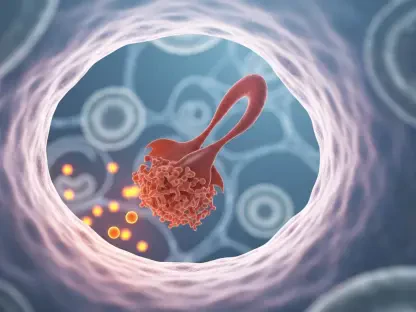In the rapidly evolving field of bioengineering, collaboration stands at the forefront, driving transformative advancements that hold the potential to address significant health and environmental challenges. Bioengineering, or biomedical engineering, combines engineering principles with biological sciences to develop innovative solutions, revolutionizing everything from healthcare delivery to agricultural practices. At its core, this interdisciplinary field is about unifying diverse expertise to pave new paths toward progress. With its inception influenced by selective breeding practices in ancient agriculture, the field has burgeoned to include groundbreaking efforts such as genetic engineering and robotic surgery. The lexicon of bioengineering itself was established in 1954 by British scientist Heinz Wolff, whose contributions laid the groundwork for this expanding domain. Today, breakthroughs like the nanoinjection platform exemplify bioengineering’s vast impact, evidencing the shift toward more precise and efficient drug delivery systems. As bioengineering advances further, it underscores an essential paradigm: collaborative efforts among scientists, engineers, and medical professionals drive its promising potential.
Historical Foundations and Evolution
Bioengineering’s roots reach far back into history, with its methodologies tracing to 8000 BCE through selective breeding. This early bioengineering practice allowed humans to modify plants and animals, optimizing them for agricultural needs. However, the term “bioengineering” itself came into use much more recently, coined by Heinz Wolff in the mid-20th century. Wolff played a pivotal role, exemplified by his development of an automatic blood cell counting machine. This, along with other pioneering work, established the foundation upon which contemporary bioengineering is built, showcasing the application of engineering concepts to solve biological and medical dilemmas.
Over the decades, bioengineering has expanded significantly, embracing technological advancements and novel scientific insights. This expansion encompasses diverse disciplines such as genetic engineering, regenerative medicine, and molecular biology, illustrating bioengineering’s broad reach and impact. The Monash Institute of Pharmaceutical Sciences’ development of the nanoinjection platform, alongside Deakin University researchers, stands as a testament to the field’s dynamic growth. This platform represents just one example of bioengineering’s potential, highlighting its capability to revolutionize healthcare through cutting-edge drug delivery systems. By leveraging interdisciplinary knowledge, bioengineering continues to push the boundaries, underscoring how its evolutionary path is intricately linked to collaboration and shared goals.
Collaborative Frameworks in Bioengineering
Collaboration serves as the bedrock of bioengineering’s significant advances. Within this framework, interdisciplinary teams draw from various fields, uniting engineering, biology, chemistry, and medicine. These collaborative ventures foster a unique environment where differences in expertise converge, enabling the creation of new scientific concepts and methods. Such partnerships are illustrated in landmark studies, such as “The art and science of collaboration in bioengineering research,” which highlight the necessity of an integrated approach in overcoming complex biological challenges.
To facilitate effective collaboration, institutions and centers dedicated to bioengineering research provide vital support. Renowned facilities like the Melbourne Centre for Nanofabrication and the London Centre for Nanotechnology offer open access to state-of-the-art equipment, becoming hubs where disciplines intersect and ideas flourish. These centers act as intellectual bridges, enabling experts from different domains to work together seamlessly. Furthermore, financial assistance through grants and initiatives bolsters these collaborative projects, enhancing resource availability and fostering innovation. Strategic international alliances, exemplified by PharmAlliance, involving key academic institutions, enhance cross-institutional research efforts, ensuring a global exchange of ideas and technological advancement.
Future Directions and Potential
As bioengineering looks to the future, the field is positioned for exponential growth, offering promising developments that could redefine modern society’s approach to health and environmental issues. Innovations poised for emergence include personalized medicine, which leverages patient-specific data to craft tailor-made treatment plans, and artificial organs, a testament to bioengineering’s potential to extend life expectancy and improve its quality. Additionally, refined drug delivery mechanisms, such as the aforementioned nanoinjection platform, promise to enhance the efficacy and precision of healthcare interventions, reducing side effects and improving patient outcomes.
Beyond healthcare, bioengineering holds promise for environmental sustainability through advancements in agricultural bioengineering. These innovations aim to increase crop efficiency and reduce the environmental impact of farming practices, contributing to a more sustainable future. As global challenges intensify, this interdisciplinary field will likely continue its trajectory toward providing holistic solutions. By marrying scientific rigor with creative problem-solving and leveraging collaborative insight, bioengineering remains poised to confront pressing global issues with ingenuity and effectiveness.
The Path Forward
In the swift-moving realm of bioengineering, collaboration is pivotal, driving transformative progress to tackle substantial health and environmental issues. Bioengineering, also known as biomedical engineering, merges engineering principles with biological sciences to create innovative solutions that revolutionize healthcare and agriculture. This interdisciplinary field focuses on integrating diverse expertise to pioneer new progress paths. Its roots trace back to ancient agricultural selective breeding, growing over time to encompass innovations like genetic engineering and robotic surgery. The very term “bioengineering” was coined in 1954 by British scientist Heinz Wolff, whose work laid the foundation for this expansive field. Today, innovations such as the nanoinjection platform highlight bioengineering’s broad impact, demonstrating shifts toward more precise and efficient drug delivery methods. As the field advances, it underscores a crucial paradigm: the promising potential of bioengineering is driven by collaborative efforts among scientists, engineers, and medical professionals.









